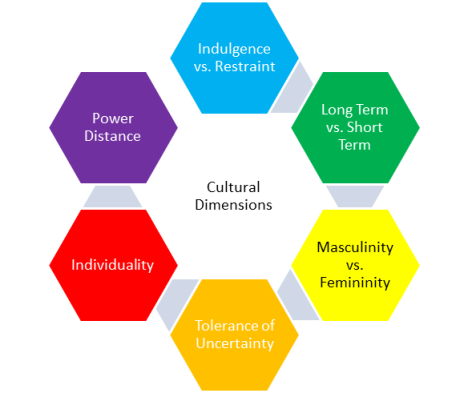Hofstede’s Six Dimensions of Culture

The Hofstede model of national culture consists of six dimensions. The cultural dimensions represent independent preferences for one state of affairs over another that distinguish countries (rather than individuals) from each other.
- Power distance describes how people belonging to a specific culture view power relationship between people
- If High = respect for authority, don’t question authority, unequal distribution is okay
- If Low = more equal distribution of power, ask question? Why?
- Uncertainty avoidance is referring to a lack of tolerance for ambiguity and a need for formal rules and policies
- If High = rules, no risks
- If Low = more comfortable with unclear situations (it’s okay with ambiguity)
- Masculinity vs. Feminity the extent to which people value the achievement of goals and the importance of status over the process of goal achievement
- Masculinity = you live to work, success driven, fixed roles
Example: doctor must a man not woman or; a man should work and a woman stay at home taking care of children
- Masculinity = you live to work, success driven, fixed roles
- Feminity = balenced life ( you work to live , open roles )
Example: it’s okay if a woman be a doctor and work for herself - Individualism vs. Collectiveness, expresses the extent to which the loyalty of individuals lies with themselves first or whether their individual loyalty lies first with the group they belong to
- Individualism: “me”
- Collectiveness: “we”
- Longterm vs. Shortterm orientation =
- Longterm orientation is when you are focused on the future (Future)
- Shortterm orientation is when you are focused on the present and consider it more important than the future (Now)
- Indulgence vs. Restraint =
- Indulgence stands for a society that allows relatively free gratification of basic and natural human drives related to enjoying life and having fun.
- Restraint stands for a society that suppresses gratification of needs and regulates it by means of strict social norms.
References
Keri E. Pearlson& Carol S. Saunders. (–). Strategic Management of Information Systems. 05. John Wiley & Sons Singapore. . ISBN: 978-1-118-32254-3.

